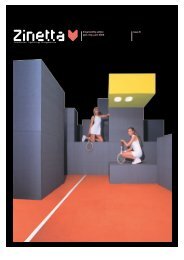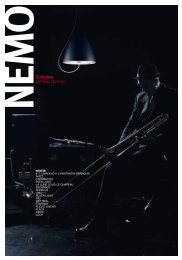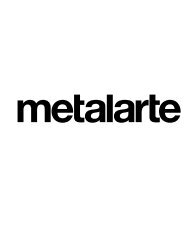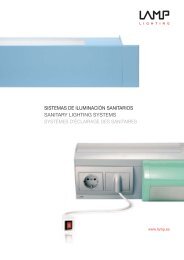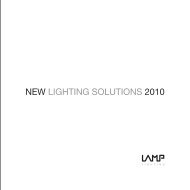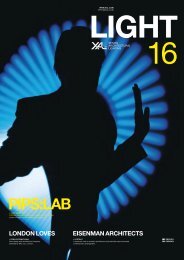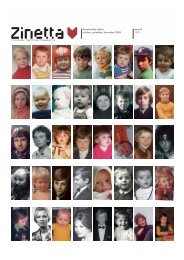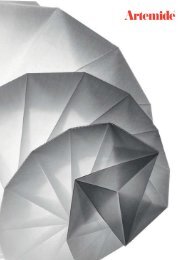WWW.XAL.COM office@xal.com XENON ARCHITECTURAL ...
WWW.XAL.COM office@xal.com XENON ARCHITECTURAL ...
WWW.XAL.COM office@xal.com XENON ARCHITECTURAL ...
You also want an ePaper? Increase the reach of your titles
YUMPU automatically turns print PDFs into web optimized ePapers that Google loves.
s,m,l<br />
<strong>XAL</strong><br />
Speed<br />
Velo-City Bikeway, Toronto / Canada<br />
by Chris Hardwicke (CDN)<br />
RUF Car Factory, Bahrain / UAE<br />
by Hermann Tilke (D)<br />
Spaceport America, New Mexico / USA<br />
by Foster + Partners (UK)<br />
Speed<br />
Slow<br />
Medium<br />
RUF Car Factory, Bahrain / UAE<br />
Velo-City Bikeway, Toronto / Canada<br />
D Chris Hardwicke, Architekt (bei Sweeny<br />
Sterling Finlayson & Co. in Toronto) und Radfahrer<br />
(als aktives Mitglied des Toronto Cycling<br />
Committee) aus Überzeugung, hat eine<br />
Zukunftsvision: ein System von transparenten<br />
Fahrradtunnels, die seine Heimatstadt Toronto<br />
wie ein transparentes Spinnennetz durchziehen<br />
sollen, als muskelbetriebene Individual-Hochbahn<br />
gewissermaßen, die die Lebenskultur<br />
seiner Stadt grundsätzlich neu definieren würde.<br />
Sein Velo-City Netzwerk hochgelegener, glasüberdachter<br />
Bike-Röhren soll dabei möglichst<br />
sanft mit der städtischen Infrastruktur umgehen<br />
und keine neuen Schneisen ins urbane Gefüge<br />
schlagen. Stattdessen plant Hardwicke, seine<br />
futuristischen Radweg-Röhren entlang bestehender<br />
Wege und Verkehrsadern zu führen:<br />
Stadtautobahnen, Eisenbahngeleise, Hochspannungsleitungen<br />
etc. Das Ziel: kein dichtes<br />
Innenstadt-Radwege-Netzwerk zu errichten<br />
(dort, so sagt Hardwicke, sind konventionelle<br />
Radwege durchaus ausreichend), sondern größere<br />
Entfernungen zu überbrücken und entfernte<br />
Stadtteile miteinander gewissermaßen durch<br />
Fahrrad-Autobahnen zu verbinden. Die transparenten<br />
Fahrradröhren sollen in ca. 5 m Höhe<br />
auf schmalen Pfeilern montiert werden. Rampen<br />
unterhalb der Röhren sollen Radfahrern die Zufahrt<br />
ermöglichen, wobei der Neigungswinkel<br />
nicht nur fahrrad- sondern auch rollstuhlfreundlich<br />
ausgelegt werden soll. Nach Hardwickes<br />
Berechnungen sollen die geschlossenen Röhren<br />
auch entscheidende Vorteile in puncto Luftwiderstand<br />
bieten und so die Effizienz der muskelbetriebenen<br />
Fortbewegung um bis zu 90 % steigern.<br />
Die theoretischen Vorteile von Velo-City<br />
liegen auf der Hand: leiser, umweltfreundlicher<br />
Verkehr mit einem Siebtel des Platzbedarfs<br />
von Auto-Verkehrswegen. Und die optimierte<br />
Aerodynamik der Röhren soll sich auch durch<br />
einen sportlichen Nebeneffekt bezahlt machen:<br />
Reisegeschwindigkeiten von bis zu 50 km/h sind<br />
darin auch für Normalradfahrer erzielbar. Zum<br />
Vergleich: die Durchschnittsgeschwindigkeit der<br />
Tour de France liegt derzeit bei ca. 40 km/h.<br />
E Chris Hardwicke, an architect (at Sweeny<br />
Sterling Finlayson & Co. in Toronto) and cyclist<br />
(as an active member of the Toronto Cycling<br />
Committee) by conviction, has a vision of the<br />
future: A system of transparent bicycle tunnels<br />
that will criss-cross his hometown of Toronto<br />
like a see-through spider’s web, as a musclepowered<br />
personal elevated track as it were,<br />
which would fundamentally redefine the living<br />
culture of his city. The elevated, glass-covered<br />
bike tubes of his Velo-City Network should treat<br />
the urban infrastructure as gently as possible<br />
and not beat any new forest aisles into the urban<br />
jungle. Instead, Hardwicke is planning to run his<br />
futuristic cycle path tubes along existing roads<br />
and traffic arteries: Urban expressways, railway<br />
tracks, high-voltage lines, etc. The objective is<br />
not to install a dense inner-city network of cycle<br />
tracks (there are more than enough conventional<br />
cycle paths there already, says Hardwicke), but<br />
to bridge larger distances and link remote city<br />
districts with each other through some form<br />
of bicycle motorways. The transparent bicycle<br />
tubes would be installed on narrow supports at<br />
a height of about 5 metres. Ramps beneath the<br />
tubes will give cyclists access, with the slope<br />
angle designed to be not only bicycle, but also<br />
wheelchair-friendly. According to Hardwicke’s<br />
calculations, the enclosed tubes should also offer<br />
decisive advantages in terms of drag and thus<br />
increase the efficiency of this muscle-powered<br />
form of lo<strong>com</strong>otion by up to 90%. The theoretical<br />
benefits of Velo-City are plain to see: Quiet, environmentally<br />
friendly traffic using a seventh of the<br />
space taken up by roads designed for cars. And<br />
the optimised aerodynamics of the tubes should<br />
also pay for themselves with a sporty side-effect:<br />
Travelling speeds of up to 50 km/h (31 mph) can<br />
also be achieved in them by normal cyclists. By<br />
<strong>com</strong>parison, the average speed of the Tour de<br />
France is currently about 40 km/h (25 mph).<br />
I Chris Hardwicke, architetto (presso Sweeny<br />
Sterling Finlayson & Co. in Toronto) e ciclista<br />
(<strong>com</strong>e membro attivo del Toronto Cycling Committee)<br />
ha una visione convinta per il futuro: un<br />
sistema capillare ed etereo <strong>com</strong>e la tela di un<br />
ragno di tunnel trasparenti per ciclisti che dovrebbero<br />
attraversare Toronto, sua città natale,<br />
<strong>com</strong>e una sorta di sopraelevata individuale che,<br />
utilizzando <strong>com</strong>e mezzo di trazione la forza dei<br />
muscoli, ridefinirebbe in modo nuovo non solo<br />
la mobilità ma lo stesso modo di vivere la città.<br />
La sua rete Velo-City costituita da tubi ciclabili<br />
sopraelevati con copertura in vetro dovrà avere il<br />
minimo impatto possibile sulle infrastrutture cittadine<br />
evitando di tracciare nuove piste nel tessuto<br />
urbano. Hardwicke progetta, infatti, di installare<br />
i suoi futuristici tubi ciclabili abbinandoli a vie e<br />
arterie di traffico già esistenti: autostrade urbane,<br />
binari della ferrovia, linee dell’alta tensione ecc.<br />
L’obiettivo non è quello di realizzare una fitta rete<br />
di piste ciclabili nel centro della città (lì le piste<br />
ciclabili tradizionali, afferma Hardwicke, sono più<br />
che sufficienti), ma di superare distanze più consistenti<br />
e collegare quartieri della città lontani tra<br />
loro mediante queste autostrade per biciclette. I<br />
tubi ciclabili trasparenti dovrebbero essere montati<br />
a circa 5 m di altezza su piloni sottili. Delle<br />
rampe collocate al di sotto dei tubi consentiranno<br />
l’accesso ai ciclisti e avranno pendenze adatte<br />
non solo alle biciclette ma anche alle sedie a rotelle.<br />
Secondo i calcoli di Hardwicke i tubi chiusi<br />
dovrebbero assicurare vantaggi determinanti in<br />
fatto di resistenza dell’aria e migliorare l’efficienza<br />
della pedalata e l’andatura fino al 90 %. I vantaggi<br />
teorici di Velo-City sono evidenti: circolazione<br />
silenziosa ed ecologica con un settimo dell’ingombro<br />
causato dalle strade per le automobili.<br />
Inoltre l’aerodinamica ottimizzata dei tubi avrà<br />
anche un effetto secondario del tutto apprezzabile<br />
sul piano sportivo: dentro questi tubi anche<br />
i ciclisti normali potranno raggiungere andature<br />
sostenute, fino a 50 km/h. Per fare un paragone,<br />
la velocità media che si tiene attualmente al Tour<br />
de France si aggira sui 40 km/h.<br />
D Nicht nur im F1-Rennstreckenbau gilt der<br />
deutsche Architekt und Amateurrennfahrer Hermann<br />
Tilke als weltweit führender Experte, u.a.<br />
mit Kursen in Malaysia, China, Japan, Italien,<br />
Deutschland, Österreich, der Türkei oder Spanien,<br />
die Tilke seit Mitte der neunziger Jahre errichtete.<br />
Auch für eine Legende des deutschen Automobilbaus<br />
sorgte Tilke nun nahe des ebenfalls von<br />
ihm konzipierten neuen F1-Rennkurses in Bahrain<br />
für ein Kompetenzzentrum der besonderen Art:<br />
seit den sechziger Jahren gilt die deutsche RUF<br />
Automobile GmbH mit Stammsitz im bayrischen<br />
Pfaffenhausen als hochexklusiver Veredler und<br />
Optimierer einer langjährigen Ikone der Hochleistungs-Sportwagenszene<br />
– des Porsche 911. Die<br />
jährlich nur etwa 35 von Hand und nach individuellen<br />
Kundenwünschen maßgefertigten Exemplare<br />
des raren RUF-Neunhundertelfers gelten<br />
unter Autoliebhabern, Rennfahrern und Sammlern<br />
als begehrtes Hochgeschwindigkeitsjuwel mit oft<br />
jahrelangen Wartelisten. Als erstes Automobilwerk<br />
in der arabischen Welt soll das neue Produktionsund<br />
Montagewerk von RUF in Bahrain, dessen<br />
Lichtschutzlamellen an der Fassade aus manchen<br />
Blickwinkeln nicht ganz zufällig wie die Kühlrippen<br />
eines Motorblocks wirken, nun die Fertigung in<br />
den kommenden Jahren um rund das Dreifache<br />
erhöhen – nicht zuletzt in Hinblick auf die kaufkräftige<br />
Klientel in den Vereinigten Arabischen<br />
Emiraten. Eingeschlossen in die Architektur des<br />
exklusiven neuen Full-Service-Produktions-,<br />
Montage- und Verkaufsstandorts auf 32.200 Quadratmetern<br />
im Business Park von Sakhir auf dem<br />
Gelände der Formel1-Rennstrecke ist eine hauseigene<br />
Forschungs- und Entwicklungsabteilung<br />
sowie der Zugang zur benachbarten Rennstrecke.<br />
Schließlich, so freuen sich Erbauer wie Betreiber,<br />
trägt die Möglichkeit, Sportwagen Tür an Tür mit<br />
einer preisgekrönten Formel-1-Piste zu bauen,<br />
eine ganz spezielle Note, bietet der bis zu 310<br />
km/h schnelle Kurs von Bahrain doch für Entwickler<br />
wie Kunden eine einmalige Gelegenheit, die<br />
Hochleistungsautomobile unter echten Rennbedingungen<br />
auf Herz und Nieren zu prüfen.<br />
E German architect and amateur racing driver<br />
Hermann Tilke is not only considered an international<br />
leading expert in the construction of Formula<br />
1 race tracks, including courses in Malaysia,<br />
China, Japan, Italy, Germany, Austria, Turkey and<br />
Spain, which he has built since the 1990s. Tilke<br />
has now also realised a <strong>com</strong>petence centre for<br />
a legend of German car building near to the new<br />
F1 race track in Bahrain, which he also designed:<br />
Since the 1960s, German <strong>com</strong>pany RUF Automobile<br />
GmbH, with headquarters in Pfaffenhausen,<br />
Bavaria, has been looked on as a highly exclusive<br />
finisher and improver of a longstanding icon on the<br />
high-performance sports car scene – the Porsche<br />
911. The rare RUF 911, of which only about 35 units<br />
customised to individual customer requirements<br />
are made by hand each year, are regarded by car<br />
lovers, racing drivers and collectors as being a<br />
coveted high-speed jewel, with waiting lists often<br />
many years long. As the first automotive factory in<br />
the Arab world, the new production and assembly<br />
plant of RUF in Bahrain, whose slatted light protection<br />
system on the façade looks not entirely coincidently<br />
like the cooling ribs of an engine block from<br />
certain angles, is intended to increase production<br />
almost three-fold in the next few years – not least<br />
due to the high purchasing power of the clientele<br />
in the United Arab Emirates. Incorporated into the<br />
architecture of the new and exclusive full-service<br />
production, assembly and sales location occupying<br />
32,300 square metres at the Sakhir Business<br />
Park on the site of the Formula 1 race track is the<br />
<strong>com</strong>pany’s own research and development department<br />
as well as access to the neighbouring<br />
race track. Ultimately, say the delighted developers<br />
and operators, the ability to build sports cars<br />
right alongside a prize-winning Formula 1 circuit is<br />
a very special touch, while the 310 km/h Bahrain<br />
circuit offers developers and customers a unique<br />
opportunity to put the high-performance cars<br />
through their paces under real racing conditions.<br />
I L’architetto tedesco Hermann Tilke, pilota di<br />
auto da corsa a livello amatoriale, è considerato<br />
uno dei maggiori esperti del mondo non solo per<br />
quanto riguarda la costruzione di circuiti automobilistici<br />
di F1, che Tilke ha costruito dalla metà<br />
degli anni Novanta per esempio in Malesia, Cina,<br />
Italia, Germania, Austria, Turchia e Spagna. Vicino<br />
al nuovo circuito di F1 del Bahrein, anche questo<br />
progettato da lui, Tilke ora ha realizzato un centro<br />
di <strong>com</strong>petenza sui generis anche per una leggenda<br />
dell’industria automobilistica tedesca: la società<br />
bavarese RUF Automobile GmbH con sede a Pfaffenhausen<br />
che dagli anni Sessanta opera <strong>com</strong>e<br />
personalizzatore e ottimizzatore altamente esclusivo<br />
di un’icona intramontabile della scena delle<br />
auto sportive di elevate prestazioni, la Porsche 911.<br />
I circa 35 esemplari della rara 911 RUF, realizzati<br />
artigianalmente ogni anno su richiesta, secondo le<br />
esigenze individuali dei clienti, sono considerati da<br />
amatori, piloti e collezionisti un ambito gioiello dell’alta<br />
velocità con liste di attesa spesso di anni. Il<br />
nuovo stabilimento di produzione e assemblaggio<br />
della RUF realizzato nel Bahrain – prima fabbrica<br />
automobilistica costruita nel mondo arabo – con<br />
una facciata protetta da brise soleil le cui lamelle<br />
viste da certe prospettive assomigliano non a<br />
caso alle alette di raffreddamento di un blocco<br />
motore, nei prossimi anni dovrebbe più o meno<br />
triplicare la produzione – con un occhio, evidentemente,<br />
al forte potere d’acquisto che caratterizza<br />
la clientela degli Emirati Arabi. Situata nel Business<br />
Park di Sakhir, nell’area del circuito automobilistico<br />
di Formula 1, l’architettura della nuova esclusiva<br />
sede full service di produzione, assemblaggio e<br />
vendita include, su una superficie di 32.200 metri<br />
quadri, un reparto di ricerca e sviluppo nonché<br />
l’accesso al vicino circuito automobilistico. Dopo<br />
tutto la possibilità di costruire auto da corsa porta<br />
a porta con una prestigiosa pista di Formula<br />
1 – auspicano costruttori e gestori – aggiunge<br />
una prerogativa del tutto speciale: il circuito del<br />
Bahrain, dove si può raggiungere una velocità di<br />
310 km/h, offre a sviluppatori e clienti l’occasione<br />
unica di provare a fondo le auto di elevate prestazioni<br />
in autentiche condizioni di gara.<br />
04<br />
<strong>XENON</strong><br />
<strong>ARCHITECTURAL</strong> LIGHTING<br />
Magazine 15




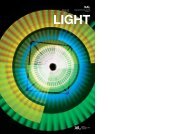
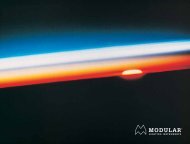
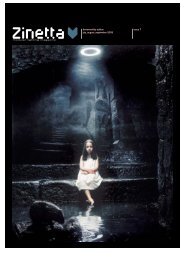

![Lataa tästä Building06 nettikirje [PDF] [591.72 KB] - Teclux](https://img.yumpu.com/41499677/1/184x260/lataa-tasta-building06-nettikirje-pdf-59172-kb-teclux.jpg?quality=85)
